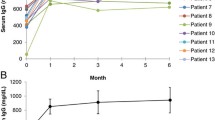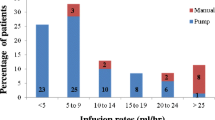Abstract
Objective
The impact of reducing immunoglobulin dosage while switching from intravenous to subcutaneous replacement therapy was evaluated.
Methods
Sixty-five patients with primary hypogammaglobulinemia on stable intravenous replacement therapy were included in a monocentric longitudinal trial. IgG trough levels were measured at baseline and during 1 year following the switch to the subcutaneous route.
Results
Mean IgG trough level after 12 months of subcutaneous therapy was increased by 5.4% (8.37–8.82 g/l, p = 0.3), while immunoglobulin dosage had been reduced by 28.3% (151–108 mg/kg/week, p < 0.0001). For the patients with the lowest serum IgG level upon intravenous infusions, serum IgG level rose by 37% (5.33–7.33 g/l, p = 0.003), while mean immunoglobulin dosage was reduced by 36% (170–109 mg/kg/week, p = 0.04).
Conclusion
The present study shows that sustained serum IgG levels can be achieved after switching towards subcutaneous replacement despite using reduced immunoglobulin doses.




Similar content being viewed by others
References
Cunningham-Rundles C, Bodian C. Common variable immunodeficiency: clinical and immunological features of 248 patients. Clin Immunol. 1999;92:34–48.
Oksenhendler E, Gérard L, Fieschi C, Malphettes M, Mouillot G, Jaussaud R, et al. Infections in 252 patients with common variable immunodeficiency. Clin Infect Dis. 2008;46:1547–54.
Winkelstein JA, Marino MC, Lederman HM, Jones SM, Sullivan K, Burks AW, et al. X-linked agammaglobulinemia: report on a United States registry of 201 patients. Medicine (Baltimore). 2006;85:193–202.
Morell A. Clinical relevance of IgG subclass deficiencies. Ann Biol Clin (Paris). 1994;52:49–52.
Cunningham-Rundles C, Siegal FP, Smithwick EM, Lion-Boulé A, Cunningham-Rundles S, O'Malley J, et al. Efficacy of intravenous immunoglobulin in primary humoral immunodeficiency disease. Ann Intern Med. 1984;101:435–9.
Busse PJ, Razvi S, Cunningham-Rundles C. Efficacy of intravenous immunoglobulin in the prevention of pneumonia in patients with common variable immunodeficiency. J Allergy Clin Immunol. 2002;109:1001–4.
Pourpak Z, Aghamohammadi A, Sedighipour L, Farhoudi A, Movahedi M, Gharagozlou M, et al. Effect of regular intravenous immunoglobulin therapy on prevention of pneumonia in patients with common variable immunodeficiency. J Microbiol Immunol Infect. 2006;39:114–20.
Wood P, Stanworth S, Burton J, Jones A, Peckham DG, Green T, et al. Recognition, clinical diagnosis and management of patients with primary antibody deficiencies: a systematic review. Clin Exp Immunol. 2007;149:410–23.
Gardulf A, Andersen V, Björkander J, Ericson D, Frøland SS, Gustafson R, et al. Subcutaneous immunoglobulin replacement in patients with primary antibody deficiencies: safety and costs. Lancet. 1995;345:365–9.
Gardulf A, Hammarström L, Smith CI. Home treatment of hypogammaglobulinaemia with subcutaneous gammaglobulin by rapid infusion. Lancet. 1991;338:162–6.
Gardulf A, Nicolay U. Replacement IgG therapy and self-therapy at home improve the health-related quality of life in patients with primary antibody deficiencies. Curr Opin Allergy Clin Immunol. 2006;6:434–42.
Gardulf A. Immunoglobulin treatment for primary antibody deficiencies: advantages of the subcutaneous route. BioDrugs. 2007;21:105–16.
Chapel HM, Spickett GP, Ericson D, Engl W, Eibl MM, Bjorkander J. The comparison of the efficacy and safety of intravenous versus subcutaneous immunoglobulin replacement therapy. J Clin Immunol. 2000;20:94–100.
Bonilla FA. Pharmacokinetics of immunoglobulin administered via intravenous or subcutaneous routes. Immunol Allergy Clin North Am. 2008;28:803–19.
Waniewski J, Gardulf A, Hammarström L. Bioavailability of gamma-globulin after subcutaneous infusions in patients with common variable immunodeficiency. J Clin Immunol. 1994;14:90–7. Steady state.
Ochs HD, Gupta S, Kiessling P, Nicolay U, Berger M, Subcutaneous IgG Study Group. Safety and efficacy of self-administered subcutaneous immunoglobulin in patients with primary immunodeficiency diseases. J Clin Immunol. 2006;26:265–73.
Berger M. Subcutaneous immunoglobulin replacement in primary immunodeficiencies. Clin Immunol. 2004;112:1–7.
Yu Z, Lennon VA. Mechanism of intravenous immune globulin therapy in antibody-mediated autoimmune diseases. New Engl J Med. 1999;340:227–8.
Gustafson R, Gardulf A, Hansen S, Leibl H, Engl W, Lindén M, et al. Rapid subcutaneous immunoglobulin administration every second week results in high and stable serum immunoglobulin G levels in patients with primary antibody deficiencies. Clin Exp Immunol. 2008;152:274–9.
Radinsky S, Bonagura V. Subcutaneous immunoglobulin infusion as an alternative to intravenous immunoglobulin. J Allergy Clin Immunol. 2003;112:630–33.
Gardulf A, Nicolay U, Asensio O, Bernatowska E, Böck A, Carvalho BC, et al. Rapid subcutaneous IgG replacement therapy is effective and safe in children and adults with primary immunodeficiencies—a prospective, multi-national study. J Clin Immunol. 2006;26:177–85.
Acknowledgments
We are grateful to the nurses from the Department of Immunology who were very enthusiastic to develop an educational program for home self-administration and to supervise the training of the patients. Most importantly, we thank the patients without whom there could be no study.
Author information
Authors and Affiliations
Corresponding author
Rights and permissions
About this article
Cite this article
Thépot, S., Malphettes, M., Gardeur, A. et al. Immunoglobulin Dosage and Switch from Intravenous to Subcutaneous Immunoglobulin Replacement Therapy in Patients with Primary Hypogammaglobulinemia: Decreasing Dosage Does Not Alter Serum IgG Levels. J Clin Immunol 30, 602–606 (2010). https://doi.org/10.1007/s10875-010-9417-2
Received:
Accepted:
Published:
Issue Date:
DOI: https://doi.org/10.1007/s10875-010-9417-2




